Cãƒâºrate Authentic Spanish Food From an American Kitchen Reviews
Spanish cuisine (Castilian: Cocina española) consists of the cooking traditions and practices from Spain. Olive oil (of which Kingdom of spain is the earth'southward largest producer) is heavily used in Spanish cuisine.[ane] Information technology forms the base of many vegetable sauces (known in Spanish as sofritos).[two] Herbs most commonly used include parsley, oregano, rosemary and thyme.[three] The apply of garlic has been noted every bit "common to all Spanish cooking."[4] The most used meats in Spanish cuisine include chicken, pork, lamb and veal.[5] Fish and seafood are besides consumed on a regular basis.[5]
Charles Perry refers to Spanish cuisine equally "an existential sort of cuisine with a tough, indomitable, living-on-the-edge character".[half dozen]
History [edit]
Artifact [edit]

Growing of the Mediterranean triad in the province of Huelva
Authors like Strabo wrote about aboriginal people of Espana using nuts and acorns equally staple food.[7] The extension of the vines along the Mediterranean seems to be due to the colonization of the Greeks and the Phoenicians who introduced the cultivation of olive oil. Spain is the largest producer of olive oil in the world. The growing of crops of the then-chosen tríada mediterránea (the "Mediterranean triad": wheat, grapevines, and olives) underpinned the staple meal products for the inhabitants of the s of the Iberian Peninsula during the Roman Era (breadstuff, wine and oil).[8]
Centre Ages [edit]
The Visigoths' limited merely lasting contributions to Spanish cuisine include the spread of consumption of fermented milks and the preference for fugitive the mixing of water and wine.[9]
Rice was possibly introduced for the offset time past Byzantines in the Iberian Peninsula by the 6th century, while, following the Muslim conquest of the Iberian peninsula in the eighth century, Arabs would also expand rice cultivation,[10] bringing new irrigation techniques originally from the Indian subcontinent that also allowed for the cultivation of crops such every bit sugar cane, watermelon, lemon and oranges.[11] Other ingredients introduced in the Iberian Peninsula during the Hispano-Muslim menstruum include sorghum, spinach, eggplant, peach, apricot, saffron and almonds.[ citation needed ] The most famous Castilian dish, Paella owes its distinctiveness to the Moorish contribution with rice and saffron.[12]

Moors also developed the basis for the fine art of pastry-making and introduced escabeche,[13] a food preservation technique relying on vinegar. Dishes like ajo blanco, salmorejo,[ farther explanation needed ] [14] alboronía ,[xv] alajú,[16] hallulla,[ description needed ] [17] albóndiga ,[eighteen] mojama,[19] arrope,[20] fideuà,[21] turrón [22] [23] are some of the many legacies of Moorish cuisine.[24] [12] [25] Although Muslim organized religion does not allow alcoholic drinks, the consumption of vino was widespread as the Qur'anic precepts never got to overrule the preexisting traditions in this regard.[26] There are many accounts of the "drinking chats" of Abd al-Rahman II, Abd al-Rahman Iii and Almanzor.[27] Almodrote (a formerly popular sauce preparation out of vogue since the late 17th century) was a Sephardic recipe in origin.[28] Observing the kashrut regulations, Jews and judaizantes opted for claret-drained meat and without fat, outright rejecting bacon.[29] Potajes were an of import office of the Jewish cuisine in the Middle Ages, most notably adafina, a local proper name for a ḥamin dish, [30] along with other Jewish culinary legacies in Spain since.[31] [32] [33] The cookbook history in the country might be traced dorsum to works such equally the Llibre de Sent Soví (1324) and Ruperto de Nola's Llibre de Coch (1520),[34] both written in the Catalan linguistic communication.
Mod era [edit]



The kitchen of the Asylum of San Bernardino in Madrid (c. 1908).
The arrival of Europeans to the Americas in 1492, initiated the advent of new culinary elements, such equally tomatoes, potatoes, maize, bell peppers, spicy peppers, paprika, vanilla and cocoa, or chocolate. Espana is where chocolate was first mixed with sugar to remove its natural bitterness. Other ingredients traveled to the Americas, such as rice, grapes, olives and many types of cereals.[35] Spain was the span for the Columbian exchange between the rest of Europe and the New World.[36]
Influenced by Standard arabic harisa, grain-based soups such equally farinetes (forth the Mediterranean coast) and, similarly, gachas (in Castile) were customary in Early Modern Spain.[37]
Foreign visitors noted with disdain the Spaniards' use of olive oil and (squealer's) lard for cooking rather than their preferred (cow'southward) butter. The latter was barely bachelor and according to the 17th-century business relationship of Madame d'Aulnoy, when information technology actually was it came "from afar, preserved in pig'southward tripes and full of worms". Butter was only locally produced in places such equally Galicia, Asturias or Soria (or it was imported: the and so-called "Flanders' butter", preserved in potassium nitrate).[38]
By the 18th century, many American ingredients, such every bit peppers and tomatoes, had been already fully incorporated to the Castilian cuisine, bringing new stiff flavours; contemporary foreign visitors such as French ambassador Jean-François de Bourgoing, judged negatively this gastronomic synthesis happening in Spain by the late part of the century: "Spanish cooking, which they accept inherited, is not by and large pleasing to foreigners. Spaniards similar strong condiments such equally pepper, tomato plant sauce, hot peppers and saffron, which color or infect nearly all their dishes".[39]
Many traditional Spanish dishes such as tortilla de patata (an omelette fabricated with potatoes), would not exist possible without the Columbian exchange. Gazpacho, salmorejo, and pan con tomate are made with tomatoes, which traveled from the New World to the Old World.[ citation needed ]
For well-nigh of the 19th century, the elite consumed a set of dishes that was largely an simulated of French cuisine. That was the bachelor cuisine at the time, together with the degeneration of regional cuisines.[40] A positive foreign take on the Spanish dishes opposing the largely negative views from foreign commentators was that of Richard Ford, fond of Spanish specialties such as Sherry and ham.[xl]
Modernistic Spanish cuisine was gestated in the late 19th to early on 20th century, with gastronomes and writers such equally Mariano Pardo de Figueroa (Dr. Thebussem), José Castro y Serrano, Ángel Muro, Emilia Pardo Bazán and Dionisio Pérez, some of which put an endeavour in developing the thought of a "national cuisine" recognisable past Spaniards equally their ain.[41]
Keen on participating in the Spanish nation-building process, Dr. Thebussem, in an autochthonous example of culinary nationalism, proposed to the King's Chef that the olla podrida (a rustic stew typically made of meat, legumes and other vegetables) should be served at official banquets as a national dish.[42] This tin be considered as an important step to stray away from the French cooking paradigm,[43] hegemonic in the 19th century in Europe. Olla podrida had been indeed previously ridiculed in foreign (well-nigh notably French) satires.[44]
Although the new foodscape built in opposition to the French centralist culinary model accounted for the sensation of the distinctive regional singularities, subsequent nutrient writers in the country would continue to cope with the tension between the Castilian peripheral and centralist foodscapes.[45]
The extremely influential cooking book 1080 recetas de cocina by Simone Ortega (kickoff published in 1972) became a hit in Spain, remaining as of 2019 the 3rd best-selling book always in the history of the state later Don Quixote and the Bible.[46] This was however not a volume exclusively of Spanish traditional recipes, merely to a big extent information technology included French recipes, bringing an exotic penchant to the Spanish homes.[46]
Televised cooking shows started in the country in 1984 with Con las manos en la masa.[47]
Meal routines [edit]

Chocolate con churros, a popular repast served for breakfast
A continental-mode breakfast (desayuno) may exist taken simply afterward waking up, or before inbound the workplace. Common products taken during breakfast include coffee, milk, chocolate potable, biscuits (most notably Marie biscuits), magdalenas, toasts (featuring ingredients such as oil, tomato and butter, staff of life toasts are a staple office of the desayuno either consumed at domicile or in bars) or churros.[48]
Due to the large time span betwixt breakfast and lunch, it is not uncommon to halt the working schedule to take a mid-morn snack.
Lunch (el almuerzo or simply la comida, literally meaning "the food"), the large midday meal in Spain, contains several courses, especially in restaurants. In some regions of Spain, the word almuerzo refers to the mid-morning snack, instead of lunch. Lunch ordinarily starts between 2:00 pm or 2:xxx pm finishing around 3:00 pm to 3:30 pm, and is usually followed by sobremesa, which refers to the table talk that Spanish people undertake. Menus are organized according to these courses and include five or 6 choices in each grade. At habitation, Spanish meals would contain ane or two courses and a dessert. The content of this meal is normally a soup dish, salad, a meat or a fish dish and a dessert such as fruit, yoghurt or something sweet. Tapas may also be typically served before or during lunch.
In recent years[ clarification needed ], the Spanish authorities took action to shorten the lunch interruption, in order to stop the working day earlier. Most businesses shut downward for 2 or 3 hours for lunch, and then resume the working twenty-four hours until dinner fourth dimension in the evening.[49] [l]
La cena, meaning both dinner or supper, is taken between 8:30pm and 11pm. It typically consists of ane course and dessert. Due to the large time span between lunch and dinner, an afternoon snack, la merienda, equivalent to afternoon tea, may take place at nearly 6pm. At merienda, people would typically drink java, eat something sweetness, a sandwich or a piece of fruit.
Some country-wide staple dishes common throughout Spain include croquetas (croquettes), paella (a rice dish incorporating different ingredients as it moves away from the area of origin in the Valencia region), ensaladilla rusa (the local name for the Olivier salad), gazpacho (a vegetable cold soup) and tortilla de patatas (Spanish omelette).[51] There is a disagreement in Spanish lodge when it comes to preferring onion as an ingredient in the Spanish omelette, ofttimes accompanied by exclusionary and tearing takes by either side.[52]
-
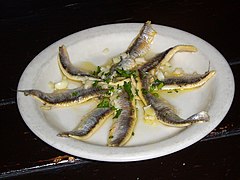
Boquerones en vinagre
-

Croquetas
-

Pincho de tortilla
-

Mejillones en escabeche
Appetizers right earlier lunch or dinner, or during them, are common in the class of tapas (small portions). It is common for tapas to be provided as a complimentary appetizer in bars and cafes when ordering a drink.[53] Aside from some of the aforementioned specialties, other signature tapas include: mejillones en escabeche (marinated mussels), gildas , albóndiga (meatballs), callos, torreznos or raxo de cerdo.[54]
Spanish regional variation [edit]
The following is a list of traditional Spanish meals:
Andalusia [edit]

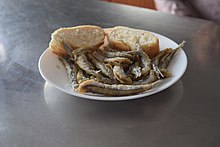
Boquerones fritos (deep-fried anchovies).
Andalusian cuisine is twofold: rural and coastal. Of all the Spanish regions, this region uses the most olive oil in its cuisine. The Andalusian dish that has achieved the most international fame is gazpacho, from Hispanic Arabic gazpáčo.[55] Information technology is a cold soup made with five vegetables, vinegar, water, salt, olive oil, and stale bread crumbs. Other cold soups include poleá, zoque and salmorejo.
Snacks made with olives are common. Meat dishes include flamenquín, pringá, oxtail stew, and menudo gitano (likewise called Andalusian tripe). Hot soups include sopa de gato (made with staff of life), caldillo de perro (fish soup with orangish juice) and migas canas. Fish dishes include pescaíto frito, soldaditos de Pavía, and parpandúa . A culinary custom is the typical Andalusian breakfast, which is considered to be a traditional feature of laborers which is extending throughout Kingdom of spain.
Cured meats include Serrano ham and Iberico ham. Typical drinks in the area include anise, wine (such as Malaga, Jerez, and Pedro Ximénez), and sherry brandy.
Aragon [edit]
Aragonese cuisine has a rural and mountainous origin. The central part of Aragon, the flattest, is the richest in culinary specialties. Being in a land where lambs are raised on the slopes of the Pyrenees, one of its near famous dishes is roast lamb, or asado de ternasco. The lamb is cooked with garlic, table salt, and bacon fatty. Pork dishes are also very popular. Among them, magras con tomate , roasted pork leg[ description needed ], and almojábanas de cerdo [ description needed ].[56] Among the recipes made with bread are migas de Pastor, migas con chocolate , regañaos , and goguera . The near notable additive is garlic oil.
Legumes are very of import, but the most pop vegetables are borage and thistle. In terms of cured meats, jamón de Teruel and also ham from Huesca are used frequently. Among the cheeses, queso de Tronchón is notable. Fruit-based cuisine includes the very pop fruits of Aragon (Spanish: frutas de Aragon, which are candy-coated fruits) and maraschino cherries.
Asturias [edit]

Asturian fabada (bean stew)
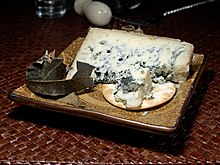
Astur-leonese cuisine has a long and rich history, securely rooted in Celtic traditions of Atlantic Europe.[ citation needed ] Ane of its well-nigh famous dishes is fabada asturiana. Fabada is the traditional stew of the region, made with white beans, sausages (such as chorizo and morcilla ), and pork. A well-known recipe is fabes con almejas (beans with clams). Asturian-leonese beans (fabes) can also be cooked with hare, partridge, prawns, or octopus. Besides of note are pote asturiano (made with white beans, cabbage, potatoes and a variety of sausages and salary) and potaje de vigilia .
Pork-based foods, for example, chosco , callos a fifty'asturiana and bollu preñáu (chorizo-stuffed bread rolls), are popular. Common meat dishes include carne gobernada (roasted veal), cachopo (a crunchy, crumb-coated veal steak stuffed with ham and cheese), and caldereta . Fish and seafood play an of import role in Astur cuisine. The Cantabrian Body of water provides a rich diversity of species, including tuna, hake and sardines.
Asturian cheeses are very popular in the rest of Spain. Among them, the most representative is Cabrales cheese, a pungent, bluish cheese developed in the regions near the Picos de Europa. Other popular cheese types are gamonéu afuega'fifty pitu, and queso de Pría . These can be enjoyed with the local cider, a low-alcohol drink made of Astur-leonese apples, with a distinctive sourness.
Asturian cider, Sidra de Asturias , fabricated of a special type of apple, is traditionally poured escanciada from a certain height, usually over the head of the waiter/server: one hand holds the glass, slightly tilted, under the hip, while the other mitt throws the cider from atop, the arm unremarkably stretched upwardly. When the cider falls into the glass from above, the drink "breaks", getting aerated and bubbly. It is consumed immediately later on being served, in sequent, tiny shots.
Notable desserts are frisuelos (like to crêpes, commonly filled with cream or apple tree jam), rice pudding (white rice cooked with milk, lemon zest and sugar), and carbayón (dulce) (puff pastry cakes filled with almond mash and covered with sugar glaze).
Balearic Islands [edit]
Balearic cuisine has purely Mediterranean characteristics due to its location. The islands have been conquered several times throughout their history by the French and the English, which left some culinary influences. Some well known nutrient items are the sobrassada, arroz brut , mahón cheese, gin de Menorca (pelota), and mayonnaise. Among the dishes are tumbet, frito mallorquín , and roasted suckling pig. Popular deserts include ensaïmada, tambor d'ametlla, and suspiros de Manacor. Balearic food is an example of the famous Mediterranean diet due to the importance of olive oil, legumes, unrefined cereals, fruits, vegetables and fish.
Basque Land [edit]

The cuisine of the Basque State has a wide and varied range of ingredients and preparations. The culture of eating is very strong amongst the inhabitants of this region.[ clarification needed ] Highlights include meat and fish dishes. Among fish, cod (bacalao) is produced in various preparations: bacalao al pil pil , bacalao a la vizcaína , to proper noun a few. Also popular are anchovies, bream, and bonito. Among the nigh famous dishes is changurro . Common meat dishes are beef steaks, pork loin with milk, fig leaf quail, and marinated goose.
Txakoli or chacolí (a white wine characterised past its high acidity and a lesser-than-boilerplate alcohol content) is a staple beverage from the Basque Country, produced in Álava and Biscay.[57]
Canary Islands [edit]

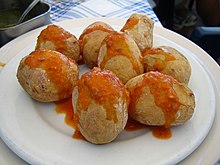
The Canary Islands have a unique cuisine due to their geographical location in the Atlantic ocean. The Canary Islands were part of the trading routes to the Americas, hence creating a melting pot of different culinary traditions. Fish (fresh or salted) and potatoes are amid the most mutual staple foods in the islands. The consumption of cheese, fruits, and pork meat also characterizes Canarian cuisine. The closeness to Africa[ dubious ] influences climate and creates a range of warm temperatures that in modern times have fostered the agriculture of tropical and semitropical crops: bananas, yams, mangoes, avocados, and persimmons which are heavily used in Canarian cuisine.
The aboriginal people, Guanches, based their nutrition on gofio (a type of flour made of different toasted grains), shellfish, and caprine animal and pork products. Gofio is still consumed in the islands and has become function of the traditional cuisine.
A sauce chosen mojo is very common throughout the islands. Information technology has been adapted and adult in many means, then that it may complement various main dishes. Fish dishes usually require a "dark-green mojo" fabricated from coriander or parsley, while roasted meats require a red variety made from chilli peppers that are commonly known as mojo picón.
Some classic dishes in the Canary Islands include papas arrugadas, almogrote, frangollo, rabbit in "salmorejo sauce", and stewed goat.
Some popular desserts are: truchas (pastries filled with sweetness tater or pumpkin), roasted gofio (a gofio-based dough with nuts and honey), príncipe Alberto (a mousse-like preparation with almonds, coffee, and chocolate), and quesillo (a variety of flan made with condensed milk).
Wineries are mutual in the islands. However, but Malvasia wine from Lanzarote has gained international recognition.
Cantabria [edit]

Cantabrian cocido montañés
A popular Cantabrian dish is cocido montañés (highlander stew), a rich stew made with beans, cabbage, and pork.
Seafood is widely used and bonito is present in the typical sorropotún or marmita de bonitu (tuna pot).
Recognized quality meats are Tudanca veal and game meat.
Cantabrian pastries include sobaos and quesadas pasiegas. Dairy products include Cantabrian cream cheese, smoked cheeses, picón Bejes-Tresviso, and quesucos de Liébana .
Orujo is the Cantabrian pomace brandy. Cider (sidra) and chacoli wine are as well favorites.[58] [59]
Cantabria has two wines labelled Dr.: Costa de Cantabria and Liébana.
Castile-La Mancha [edit]

In Castilla-La Mancha, the culinary habits reflect the origin of foods eaten past shepherds and peasants. It is said that the best La Mancha cuisine cookbook is the novel Don Quixote by Miguel de Cervantes. Wheat and grains are a dominant production and ingredient. They are used in staff of life, soups, gazpacho manchego, crumbs[ clarification needed ], porridge, etc. I of the virtually arable ingredients in Manchego cuisine is garlic, leading to dishes such as ajoarriero , ajo puerco, and garlic marinade[ clarification needed ].
Some traditional recipes are gazpacho manchego, pisto manchego, and migas ruleras . As well popular is morteruelo , a kind of foie gras manchego. Manchego cheese is likewise renowned.
Given the fact that its lands are dry, and thus unable to sustain big amounts of cattle living on grass, an abundance of small animals, such equally rabbit, and especially birds (pheasant, quail, partridge, squab), can be found. This led to game meat being incorporated into traditional dishes, such as conejo al Ajillo (rabbit in garlic sauce), perdiz escabechada (marinated partridge) or huevos de codorniz (quail eggs)).
Castile and León [edit]

In Castile and León characteristic dishes include morcilla, (a black pudding made with special spices), judión de la Granja , sopa de ajo (garlic soup), Cochinillo asado (roast piglet), lechazo (roast lamb), botillo del Bierzo, hornazo from Salamanca, jamón de Guijuelo (a cured ham from Guijuelo, Salamanca), salchicha de Zaratán, other sausages, Serrada cheese[ description needed ], queso de Burgos , and Ribera del Duero wines.
Major wines in Castilian-Leonese cuisine include the robust wine of Toro, reds from Ribera del Duero, whites from Rueda, and clarets from Cigales.
Catalonia [edit]

The cuisine of Catalonia is based in a rural culture; it is very extensive and has swell culinary wealth. It features cuisine from 3 climates: coastal (seafood), mountains, and the interiors. Some famous dishes include escudella, pa amb tomàquet, bean omelette[ clarification needed ], coca de recapte , samfaina, thyme soup, and caragols a la llauna. Notable sauces are romesco sauce, aioli, bouillabaisse of Catalan origin and picada.
Cured pork cuisine includes botifarra (white and black) and the fuet of Vic.
Fish dishes include suquet (fish stew), cod stew, and arròs negre.
Among the vegetable dishes, the nearly famous are calçots and escalivada (roasted vegetables).
Desserts dishes include Catalan cream, carquinyolis, panellets, tortell, and neules.
La Rioja [edit]
La Rioja is recognized by the utilise of meats such as pork and cold cuts, which are produced afterwards the traditional slaughter. Lamb is perhaps the 2nd most pop meat product in this region (chuletillas al sarmiento ). Veal is common in mountainous areas. Some other well-known dish is caparrones, Rioja stew. The most famous dish is Rioja manner potatoes and fritada. Lesser-known dishes are Holy tiffin and ajo huevo (garlic eggs)[ clarification needed ]. Pimientos asados (roasted peppers) is a notable vegetable dish.
La Rioja is famously known in Spain for its red vino, and then near of these dishes are served with wine. Rioja vino has designated origin status.
Extremadura [edit]
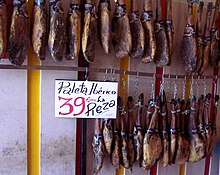
The cuisine of Extremadura is austere, with dishes prepared past shepherds. It is very similar to the cuisine of Castilla. Extremaduran cuisine is arable in pork; it is said that the region is 1 of the best for convenance pigs in Espana, thanks to the acorns that abound in their fields. Iberian grunter herds raised in the fields of Montánchez are characterized by nighttime peel and thin legs. This breed of squealer is found exclusively in Southwestern Iberia, both in Spain and Portugal. Iberian pork products such as sausages are mutual and oftentimes added to stews (cocido extremeño ), as well as cachuela (pork liver pâté seasoned with paprika, garlic and other spices).
Other meat dishes are lamb stew or goat stew (caldereta de cordero and caldereta de cabrito). Highlights include game meats, such every bit wild boar, partridge, pheasant, or venison.
Distinctive cheeses from the region include the so-called quesos de torta, sheep milk cheeses typically curdled with the infusion of thistle:[60] both the torta of La Serena and the torta of El Casar savour a protected designation of origin.[threescore] Among the desserts are leche frita, perrunilla , and pestiños (fritters), equally well equally many sweets that have their origins in convents.
Cod preparations are known, and tench is amid the most traditional freshwater fish, with fish and vegetable dishes such as moje de peces or escarapuche.

Soups are ofttimes staff of life-based and include a diversity of both hot and cold ones. Pennyroyal mint is sometimes used to season gazpachos or soups such as sopa de poleo. Extremaduran ajoblanco (ajoblanco extremeño) is a cold soup different from Andalusian ajoblanco since information technology contains egg yolk in the emulsion and vegetables but no almonds.
The Northeastern comarca of La Vera produces pimentón de la Vera , smoked paprika highly valued all over Spain and extensively used in Extremaduran cuisine.
The region is likewise known for its vino de pitarra tradition, home-made vino made in small earthenware vessels.[61]
Galicia [edit]


Galician cuisine is known in Spanish territory because of the emigration of its inhabitants. Similarly to neighbouring Asturias, Galicia shares some culinary traditions in stews and soups with the Celtic nations of Atlantic Europe.[62] One of the about noted Galician dishes is soup. Also notable is pork with turnip tops, a popular component of the Galician carnival repast laconadas. Another remarkable recipe is caldo de castañas (a chestnut broth), which is commonly consumed during winter. Pork products are also pop.[63]
The simplicity and authenticity of the Galician cooking methods were extolled already in the early 20th century past popular gastronome Manuel Puga e Parga (aka Picadillo), praising dishes such as lacón con grelos or caldeiradas (fish stew), opposed to the perceived sophistication of the French cuisine.[64]
The seafood dishes are very famous and rich in diversity. Amidst these are the Galician empanadas, octopus, scallops, crab, and barnacles. In the urban center of Santiago de Compostela, located along an ancient pilgrim trail from the Pyrenees, it was customary for travellers to first eat scallops upon arriving in the city.[65]
Amidst the many dairy products is queso de tetilla.
The queimadas (a folkloric preparation of orujo) consists of mixing of the alcoholic drinkable with peels of orange or lemon, carbohydrate or coffee beans, prepared in a virtually ritual ceremony involving the flambé of the beverage.[66]
Sweets that are famous throughout the Iberian Peninsula are the tarta de Santiago and filloas (crêpes).
Cattle breeding is very common in Galicia, therefore, a lot of red meat is consumed, typically with potatoes.
Madrid [edit]

Madrid did not gain its own identity in the Court until 1561,[ clarification needed ] when Philip Ii moved the capital letter to Madrid. Since and then, due to immigration, many of Madrid's culinary dishes accept been made from modifications to dishes from other Castilian regions. Madrid, due to the influx of visitors from the nineteenth century onwards, was one of the first cities to introduce the concept of the restaurant, hosting some of the earliest examples.[ commendation needed ]
Murcia [edit]
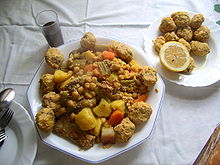
The cuisine of the region of Murcia has 2 sides with the influence of Manchego cuisine. The region of Murcia is famous for its varied fruit production. Among the almost outstanding dishes are: tortilla murciana, zarangollo, mojete, aubergine a la crème, pipirrana, etc. A typical sauce of this area is ajo cabañil, used to back-trail meat dishes.
Regional dishes include michirones (beans cooked with bay leaves, hot peppers and garlic), olla gitana, cocido murciano con pelotas, sopa de mondongo, and others.
Some meat products from Murcia are morcilla (black pudding), which is flavored with oregano, and pastel murciano, made with ground beef.
Amidst fish and seafood are the golden salt[ clarification needed ], Mar Menor prawns and broiled octopus.
Rice dishes are common and include caldero, arroz empedrado, paella Valenciana (rice with rabbit and snails), arroz de escribano, and arroz viudo.
Amidst confectionery products are exploradores and pastel de Cierva. They are typical in Murcia gastronomy and are found in almost every pastry shop in Murcia. They are both sweet and savoury at the same time.
Desserts are abundant; among them are paparajotes, Orchard[ description needed ], stuffed pastries, and others.
This region also has wine appellation of origin, every bit the vino from Jumilla, Bullas vino and wine Yecla.
[edit]

The gastronomy of Navarra has many similarities with Basque cuisine. 2 of its flag dishes are trucha a la navarra (Navarra-style trout) and ajoarriero, although we must non forget the cordero en chilindrón or relleno. There are very curious recipes such as the Carlists eggs.
Salted products are common and include chorizo de Pamplona, stuffing and sausage. The lamb and beef have, now, designations of origin. Amid the dairy products are Roncal cheese, the curd or Idiazabal cheese. Typical alcoholic drinks include claret and pacharán.
Valencia [edit]
The cuisine of Valencia has two components, the rural (products of the field) and the coastal (seafood). One popular Valencia cosmos is paella, a rice dish cooked in a round pan and topped with vegetables and meats (originally rabbit and chicken).[68] Dishes such every bit arroz con costra, arròs negre, fideuá, arròz al horn, and rice with beans and turnips are also mutual in the city.
Coastal towns supply the region with fish, leading to pop dishes like all i pebre (fish stew), typical of the Albufera.
Among the desserts are coffee liqueur, chocolate Alicante, and arnadí [69] and horchata, both of Muslim origin.[seventy] Notably, during Christmas, nougat is made in Alicante and Jijona; besides well-known are peladillas (almonds wrapped in a thick layer of caramel).
Customs [edit]
It is traditional to ready and consume pocket-size dear cakes (galletas de miel) for the banquet of Corpus Christi.[71]
Notable Castilian chefs [edit]

- Ferran Adrià of El Bulli, Girona (closed).[72]
- Juan Mari Arzak, Arzak, San Sebastián, Guipúzcoa (1989).[73]
- Santi Santamaría, El Raco, Can Fabes, Barcelona (1994).[74]
- Martín Berasategui Berasategui Lasarte, Guipúzcoa (2001).[75]
- Carme Ruscalleda Sant Pau Sant Political leader de Mar, Barcelona (2006).[76]
- José Andrés Minibar by José Andrés Washington D.C. Andres is a student of Adrià. He hosts Fabricated in Espana on PBS.[77]
- Karlos Arguiñano, celebrity television chef.[78]
- Sergi Arola, La Broché, Arola and Sergi Arola Gastro. Arola is a student of Adrià who has been awarded ii Michelin stars.[79]
- Penelope Casas, New York-born cookbook author.[lxxx] [81] [82]
- Carlos Dominguez Cidon (León 1959–2009), recipient of the "Premio Alimentos" laurels in 1999 and Michelin Guiding Star honour in 2004; author of viii books.[83] [84]
- María Mestayer de Echagüe (Bilbao b. 1878 d. 1956), also known every bit "Marquesa de Parabere", the writer of a two-volume cooking encyclopaedia entitled La Cocina Completa. At that place are sections dedicated to the pantry and table etiquette.[85] [ cocky-published source ]
- Ángel Muro, a 19th-century food proficient and writer of the book Practicón.[86]
- Simone and Ines Ortega, authors of 1080 recetas (1080 Recipes).[87]
- Manuel Maria Puga and Parga, an early 20th century food expert and author of La cocina práctica.[88]
- Ilan Hall, Casa Mono, Manhattan, NY, winner of Meridian Chef Season two.[89]
- Joan Roca, Jordi Roca i Fontané and Josep Roca i Fontané. El Celler de Can Roca, "Rocambolesc", "Tin Roca", "Mas Marroch" and "Cap Roig", in the province of Girona, and he restaurant "Roca Barcelona" in the province of Barcelona. Three Michelin stars in 2009. In 2013, El Celler de Can Roca was selected as the best restaurant in the earth past Restaurant magazine.
See also [edit]
- Early touch of Mesoamerican goods in Iberian lodge
- List of Spanish desserts
- Listing of Spanish dishes
- List of Spanish soups and stews
- Agriculture in Spain
- List of Spanish cheeses
- Bread civilization in Espana
- List of cuisines
Derivatives:
- American Cuisine
- Louisiana Creole cuisine
- Cuisine of California
- New Mexican cuisine
- Cuisine of the Southwestern United States
- Mexican cuisine
- Peruvian cuisine
- Latin American cuisine
- Filipino cuisine
- Cuban cuisine
- Puerto Rican cuisine
- Dominican Republic cuisine
- Venezuelan cuisine
- Colombian cuisine
- Uruguayan cuisine
- Argentine cuisine
- Bolivian cuisine
- Ecuadorian cuisine
- Honduran cuisine
- Guatemalan cuisine
- Costa Rican cuisine
- Chilean cuisine
- Panamanian cuisine
- Salvadoran cuisine
References [edit]
- ^ Akyürek, Suat (2018). "Investigation of similarities and differences of Turkish and Spanish cuisine cultures". Turkish Studies. Ankara. 13 (3): 49–64. doi:10.7827/TurkishStudies.12900. ISSN 1308-2140.
- ^ Martínez-Galiano, Juan Miguel; Olmedo-Requena, Rocío (2018). "Effect of Adherence to a Mediterranean Diet and Olive Oil Intake during Pregnancy on Take chances of Minor for Gestational Historic period Infants". Nutrients. 10 (9): 1234. doi:ten.3390/nu10091234. PMC6164545. PMID 30189597.
- ^ Hoffman, Richard; Gerber MD, Mariette (2011). The Mediterranean Diet: Wellness and Science. doi:x.1002/9781118785027. ISBN9781444330021.
- ^ Wild 2015, p. 99.
- ^ a b Weichselbaum, Elisabeth; Benelam, Bridget; Costa, Helena Soares (2005). "Synthesis report No 6: Traditional Foods in Europe" (PDF). European Food Information Resource Network. pp. 51–52.
- ^ Perry, Charles (12 December 1996). "Roll Out the Garlic". Los Angeles Times.
- ^ Medievalists.net (8 October 2020). "Acorns in the Middle Ages". Medievalists.net . Retrieved ane February 2021.
- ^ Ruiz López, Ildefonso David; Ramírez Ruiz, Carmen (2012). "La tríada mediterránea en las acuñaciones monetarias del sur peninsular" (PDF). Iberian (4): 57. ISSN 2174-5633.
- ^ Díaz Yubero, Ismael (1999). "Gastronomía española". Real Academia de Ciencias Veterinarias de España.
- ^ Pons Biescas, Antoni; Tur Marí, Josep A. (2005). "La alimentación en Bizancio". In Salas-Salvadó, Jordi; García-Lorda, Pilar; Sánchez Ripollés, José M.ª (eds.). La alimentación y la nutrición a través de la historia. Barcelona: Editorial Glosa. p. 180. ISBN84-7429-257-iii.
- ^ Gil Cuadrado, Luis Teófilo (2002). "La influencia musulmana en la cultura hispano-cristiana medieval". Anaquel de Estudios Árabes. 13: 58. ISSN 1130-3964.
- ^ a b "Tin can I accept Some Moor? A Look at Moorish Influence on Spanish Cuisine - Global Foodways". Adhc.lib.ua.edu . Retrieved 10 March 2022.
- ^ Díaz Yubero, Ismael. "La evolución de la alimentación y la gastronomía en España" (PDF). Biblioteca Nacional de España. pp. 121–154.
- ^ "El gazpacho de siempre no lleva tomate". 17 August 2016.
- ^ "alboronía | Diccionario de la lengua española". «Diccionario de la lengua española» - Edición del Tricentenario.
- ^ "alajú | Diccionario de la lengua española". «Diccionario de la lengua española» - Edición del Tricentenario.
- ^ "hallulla | Diccionario de la lengua española". «Diccionario de la lengua española» - Edición del Tricentenario.
- ^ "albóndiga | Diccionario de la lengua española". «Diccionario de la lengua española» - Edición del Tricentenario.
- ^ "almojama | Diccionario de la lengua española". «Diccionario de la lengua española» - Edición del Tricentenario.
- ^ "arrope | Diccionario de la lengua española". «Diccionario de la lengua española» - Edición del Tricentenario.
- ^ "fideo | Diccionario de la lengua española". «Diccionario de la lengua española» - Edición del Tricentenario.
- ^ "Diccionario español-latino-arabigo: en que siguiendo el diccionario abreviado de la Academia se ponen las correspondencias latinas y arabes, para facilitar el estudio de la lengua arábiga á los misioneros, y á los que viajaren ó contratan en Africa y Levante". A. Sancha. 11 July 1787 – via Google Books.
- ^ Víctor, Pérez Castaño (1 Jan 2016). Cocina española east internacional. Ediciones Paraninfo, S.A. ISBN9788428397339 – via Google Books.
- ^ "Cocinas" (PDF). www.bne.es . Retrieved 17 Baronial 2020.
- ^ "Influencia árabe | Cocina española". www.spanish-food.org.
- ^ Marín, Manuela (2003). "En los márgenes de la ley: el consumo de alcohol en al Andalus" (PDF). In Puente, Cristina de la (ed.). Estudios onomástico-biográficos de al Andalus (Identidades marginales) Xiii. pp. 273–274.
- ^ Marín 2003, p. 286.
- ^ Quesada, Fernando (13 March 2017). Las cosas claras y el chocolate espeso: Historias, curiosidades y anécdotas gastronómicas. Editorial Cultiva Libros Southward.Fifty. ISBN9781635037104 – via Google Books.
- ^ Cantera Montenegro, Enrique (2003). "La carne y el pescado en el sistema alimentario judío en la España medieval". Espacio, Tiempo y Forma, Serie III, Historia Medieval. Madrid: Universidad Nacional de Educación a Distancia. 16 (16): 24. doi:10.5944/etfiii.16.2003.3689.
- ^ Cantera Montenegro 2003, p. 32.
- ^ Debora Chomski. "La Cocina Judia (para celebrar la vida)" (PDF). Academiaaragonesadegastronomia.com . Retrieved x March 2022.
- ^ "Gastronomía sefardí en la Red de Juderías de España - Diario de Gastronomía: Cocina, vino, gastronomía y recetas gourmet". Diariodegastronomia.com . Retrieved ix March 2022.
- ^ "Bibliografia Sefardi" (PDF). Cervantes.es . Retrieved 10 March 2022.
- ^ Wild, Matthew J. (2015). "Eating Kingdom of spain: National Cuisine Since 1900". Theses and Dissertations-Hispanic Studies. Vol. 24. p. 30.
- ^ Medina, Xavier (2005). Food Culture in Spain (Food Civilisation around the Earth). Greenwood. ISBN978-0313328190.
- ^ Pérez Samper 2014, p. 33.
- ^ Campbell, Jodi (2017). At the First Table. Nutrient and Social Identity in Early Modern Spain. Lincoln and London: University of Nebraska Printing. p. 15. ISBN9780803296619.
- ^ Vega de Arlucea, Ana (30 May 2019). "¿Por qué hace años los extranjeros odiaban la cocina española?". La Voz de Galicia.
- ^ Pérez Samper, María de los Ángeles (2014). "The Early Modern Nutrient Revolution: A Perspective from the Iberian Atlantic". In Aram, Bethany; Yun-Casalilla, Bartolomé (eds.). Global Goods and the Spanish Empire, 1492-1824: Circulation, Resistance and Multifariousness. Palgrave Macmillan. p. 33. doi:ten.1057/9781137324054. ISBN978-one-349-45891-2.
- ^ a b Bueno, Pilar; Ortega, Raimundo (1 August 1998). "De la fonda nueva a la nueva cocina. La evolución del gusto culinario en España durante los siglos 19 y Xx". Revista de Libros.
- ^ Aguirregoitia-Martínez, Ainhoa; Fernández-Poyatos, Mª Dolores (2017). "The Gestation of Modern Gastronomy in Spain (1900-1936)". Civilisation & History Digital Journal. half-dozen (2): 019. doi:x.3989/chdj.2017.019. ISSN 2253-797X.
- ^ Anderson, Lara (2013). "The unity and diversity of La olla podrida: an autochthonous model of Spanish culinary nationalism". Journal of Spanish Cultural Studies. Routledge. fourteen (4): 400–414. doi:10.1080/14636204.2013.916027. S2CID 143940504.
- ^ Anderson 2013, pp. 402–403.
- ^ Anderson 2013, p. 404.
- ^ Anderson, Lara (2019). "Writing from and for the Periphery. Carving Out a Place for Castilian Nutrient Studies" (PDF). Repensar los estudios ibéricos desde la periferia. Vol. 13. Edizioni Ca' Foscari. p. 104. doi:10.30687/978-88-6969-302-ane/006. ISBN978-88-6969-302-ane. ISSN 2610-8844. S2CID 166399222.
- ^ a b Serna, Víctor de la (31 May 2019). "Así consiguió Simone Ortega que sus '1080 recetas' se vendan tanto como el 'Quijote'". El Mundo.
- ^ Massanés, Toni; Guitiá, Jorge (2010). "Libertad en los fogones. La cocina española y sus libros, de la transición a nuestros días" (PDF). La cocina en su tinta. Biblioteca Nacional de España. pp. 191–193. ISBN978-84-92462-15-5.
- ^ "¿Qué desayunan los españoles?". Korespa.
- ^ Working ix to 8: Spain seeks to shorten xi-hour working day The Guardian. Retrieved 2016-12-xx.
- ^ Espana, Land of x P.M. Dinners, Asks if It'due south Fourth dimension to Reset Clock The New York Times. Retrieved 2016-12-20.
- ^ Castillo, Toni (thirteen May 2015). "Los cinco clásicos de la gastronomía española". Bonvieur.
- ^ Taboada, Lucía (27 Baronial 2014). "Abordamos una cuestión de estado: La tortilla, ¿con o sin cebolla?". Revista GQ.
- ^ Jessop, Tara (27 April 2016). "A Brief History of the Globe Famous Spanish Tapas". Culture Trip . Retrieved ten July 2020.
- ^ Bonilla, Mer (twenty June 2019). "Las tapas más famosas de la cocina española y las recetas para que te salgan de lujo". El Español.
- ^ "gazpacho | Diccionario de la lengua española". «Diccionario de la lengua española» - Edición del Tricentenario.
- ^ "almojábana | Diccionario de la lengua española". «Diccionario de la lengua española» - Edición del Tricentenario.
- ^ País, El (26 January 2015). "El Ministerio de Agricultura incluye en su web la ruta del 'txakoli'". El País.
- ^ Barreda F. The chacoli Santander in the 13th to 19th centuries. Maxtor Editorial Library. 1943. 2001 edition, first reprint. ISBN 84-95636-84-0.
- ^ "'Vignobles et vins du Nord-Ouest de l'Espagne, Alain Lemps." "The txakoli of Burgos Valle de Mena wants OJ" 2005. Accessed 19 January 2008.
- ^ a b Iborra, Elisabeth G. (15 Dec 2019). "Quesos de torta extremeños: ocho preguntas para convertirnos en unos expertos". eldiario.es.
- ^ "Pitarra Wines: Spanish Wines Made with Flor". Food and Wine Tours in Portugal and Spain. 3 October 2012.
- ^ "Visualizar obra". bvg.udc.es.
- ^ "El tercer Cocido do Porco Celta registra un lleno total en Sarria". www.elprogreso.es. 21 February 2011.
- ^ Narváez, Ana (11 September 2019). "Picadillo, el alcalde que dio nombre al concurso de tapas de A Coruña". Quincemil. El Español.
- ^ Fieldhouse, Paul. The Earth Religions Cookbook. Greenwood Press. p. 90.
- ^ "Santiago de Compostela, epicentro gastronómico de Galicia". Asociación Nacional de Gastronomía y Turismo de Galicia.
- ^ Vega, Ana [Biscayenne] (21 September 2017). "Bocadillo de Calamares". El Comidista. El País.
- ^ "The Art of Paella". Retrieved 27 September 2016.
- ^ "Arnadí | Diccionario de la lengua española".
- ^ Goldstein, Darra (2015). The Oxford Companion to Carbohydrate and Sweets. ISBN9780199313396.
- ^ Fieldhouse, Paul. The World Religions Cookbook. Greenwood Press. p. 89.
- ^ "A laboratory of gustatory modality." The New York Times Sun supplement 10 August 2003.
- ^ Hughes H. "Frommer'south 500 places for food and vino lovers." John Wiley & Sons 2009 p110. ISBN 0470480645, 9780470480649. Accessed at Google Books xviii January 2014.
- ^ Keown D. "A companion to Catalan culture." Tamesis Books 2011 p247. ISBN 1855662272, 9781855662278.
- ^ Facaros D. and Pauls M. "Bilbao and the Basque lands." New Holland Publishers 2008 p190. ISBN 1860114008, 9781860114007.
- ^ Ruscadella C. "Carme Ruscadella'southward mediterranean cuisine." Salsa Books 2007. ISBN 8496599159, 9788496599154.
- ^ "Biography." Archived 10 February 2009 at the Wayback Automobile Jose Made In Spain website. Accessed xviii January 2014.
- ^ Barlow J. "Everything merely the squeal." Clic-books.com 2014 p83. Accessed at Google Books 18 Jan 2014.
- ^ Stone P. "Frommer's Barcelona". John Wiley & Sons 2011. ISBN 1119994497, 781119994497.
- ^ Casas P. The foods and wines of Kingdom of spain. (1982).
- ^ Parsons R. "Penelope Casas, pioneer of English-language Castilian cookbooks, dies." LA Times nineteen Baronial 2013.
- ^ "Penelope Casas, Castilian food writer, dies at 70." The New York Times 18 Baronial 2013. Accessed 9 September 2013.
- ^ Staff (11 January 2009). "Carlos D. Cidón propone un ambicioso programa de cursos para profesionales de la cocina". Diaro de León (in Spanish). Archived from the original on 16 July 2011. Retrieved 15 August 2010.
- ^ Staff (12 May 2009). "Fallece Carlos Domínguez Cidón, uno de los "pilares importantes" de la gastronomía de Castilla y León". Europa Press (in Spanish). Agencia Europa Press. Retrieved 15 August 2010.
- ^ "The immigrants' universe." Xlibris[ self-published source ] Corporation 2010 p128. ISBN 1456811940, 9781456811945.[ self-published source ]
- ^ Richardson P. "A Late Dinner: Discovering the Food of Spain." Bloomsbury Publishing 2008 p68. ISBN 0747593809, 9780747593805.
- ^ Anderson Fifty. "Cooking Up the Nation: Spanish Culinary Texts and Culinary Nationalization in the Late Nineteenth and Early Twentieth Century." Boydell & Brewer Ltd 2013 p2. ISBN 1855662469, 9781855662469.
- ^ Puga y Parga G. "La covina práctica." Everest Galicia, 2001. ISBN 8440305109, 9788440305107.
- ^ Food and Wine Magazine. "Bravo's New Top Chef Tells All". Retrieved 25 December 2014.
External links [edit]
- Foods and Wines from Spain
Source: https://en.wikipedia.org/wiki/Spanish_cuisine
0 Response to "Cãƒâºrate Authentic Spanish Food From an American Kitchen Reviews"
Post a Comment